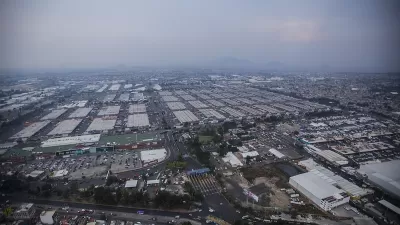A mesa in New Mexico is home to nearly 400 people, which makes up one of the largest communities of people in the U.S. living almost completely off the grid.
Wood-burning stoves and solar panels provide the heat and power to these meager houses, and water tank systems allow residents to shower and flush toilets.
"The Pajarito Mesa community, scattered over 28 square miles, is 90 percent Hispanic and mostly poor, and includes an uncounted but large number of illegal immigrants. But they are not squatters: residents buy or rent their plots, and the owners pay property taxes, one of the many oddities of a community that is isolated in plain sight.
Access to water and electricity has been stymied by a legal mess and a lack of political power in the largely nonvoting community. The mesa was never legally subdivided, no streets or rights of way for power lines were set aside, and the area was never licensed for housing.
In a small step forward, this month the mesa will finally get its first water supply - a metered spigot at a single site where people can fill their barrels, instead of having to drive anywhere from 10 to 18 miles. Getting even this much took 10 years of organizing residents and pestering state and county officials, a campaign led by Sandra Montes, a former housewife who moved to the mesa in 1997 'without realizing how hard it was going to be,' she said."
FULL STORY: On a Dusty Mesa, No Water or Electricity, but Boundless Space

Maui's Vacation Rental Debate Turns Ugly
Verbal attacks, misinformation campaigns and fistfights plague a high-stakes debate to convert thousands of vacation rentals into long-term housing.

Planetizen Federal Action Tracker
A weekly monitor of how Trump’s orders and actions are impacting planners and planning in America.

Chicago’s Ghost Rails
Just beneath the surface of the modern city lie the remnants of its expansive early 20th-century streetcar system.

Bend, Oregon Zoning Reforms Prioritize Small-Scale Housing
The city altered its zoning code to allow multi-family housing and eliminated parking mandates citywide.

Amtrak Cutting Jobs, Funding to High-Speed Rail
The agency plans to cut 10 percent of its workforce and has confirmed it will not fund new high-speed rail projects.

LA Denies Basic Services to Unhoused Residents
The city has repeatedly failed to respond to requests for trash pickup at encampment sites, and eliminated a program that provided mobile showers and toilets.
Urban Design for Planners 1: Software Tools
This six-course series explores essential urban design concepts using open source software and equips planners with the tools they need to participate fully in the urban design process.
Planning for Universal Design
Learn the tools for implementing Universal Design in planning regulations.
planning NEXT
Appalachian Highlands Housing Partners
Mpact (founded as Rail~Volution)
City of Camden Redevelopment Agency
City of Astoria
City of Portland
City of Laramie





























